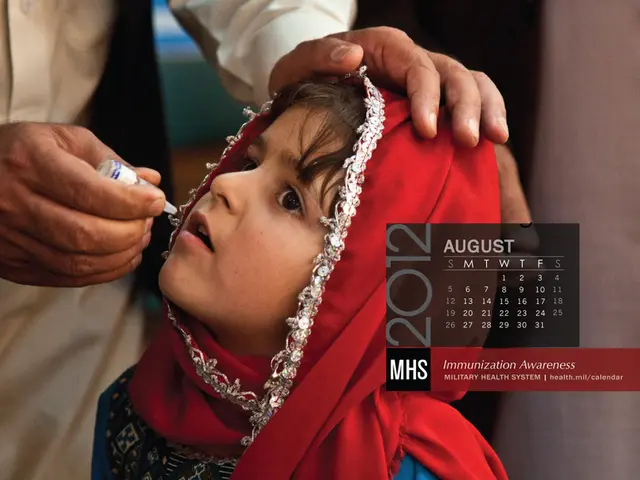Distinguishing Age Spots from Skin Cancer: A Guide to Recognition
Rewritten Article:
Skin discolorations called age spots can appear as we age, causing concern as they can resemble some types of skin cancer. However, it's essential to know the differences, so we can identify when medical advice is necessary. Here's a breakdown of age spots versus skin cancer, along with the symptoms, diagnosis, and treatments for both conditions.
Age Spotsvs. Skin Cancer: Key Differences
Surprisingly, age spots and skin cancer share similar locations on the body due to frequent sun exposure. But unlike skin cancer, age spots are harmless and do not require treatment.
Age Spots
Age spots, also known as solar lentigines or liver spots, are darker patches that crop up on the skin. They're typically flat, bordering on smooth, and don't cause any itchiness or discomfort. These spots are the skin's natural response to prolonged sun exposure, as the body produces excess melanin to protect itself.
Age spots are more common in those with lighter skin tones and tend to appear from middle age onwards.
Skin Cancer
Unlike age spots, skin cancer is harmful and can spread throughout the body. Skin cancer occurs due to sun damage, but it can also be triggered by other environmental factors or genetics. Skin cancer cells multiply and grow rapidly, potentially spreading to other parts of the body.
The primary types of skin cancer are basal cell carcinoma, squamous cell carcinoma, and melanoma. Actinic keratosis, a precancerous growth, can be mistaken for age spots.
The Rundown on Actinic Keratosis
While age spots cannot lead to cancer, actinic keratosis can evolve into skin cancer if left untreated. These precancerous growths resemble age spots, with rough, scaly patches or red, pink, or brown spots on sun-exposed skin. If you notice any growths like this, it's crucial to consult a healthcare professional.
Comparing Symptoms
By understanding the symptoms of age spots and skin cancer, you can better recognize which condition you may be dealing with.
Age Spot Symptoms
Age spots tend to be:
- flat and smooth
- Yellow, brown, or gray
- defined with clear borders
- between a few millimeters or centimeters in size
- found on sun-exposed areas, like the face, hands, feet, arms, shoulders, and back
Age spots may fade in winter and become more pronounced in summer.
Skin Cancer Symptoms
Skin cancer symptoms can vary depending on several factors. However, you should watch out for:
- Asymmetrical shape
- Irregular, blurred, or ragged edges
- Changing size, color, or shape
- Multiple colors on the same spot
- Pink, blue, purple, black, or brown coloring
- Raised, red patches
- Pale or yellow firm patches similar to scars
- Pain, itching, oozing, or bleeding
- Crusty or scaly patches
- Raised edges that lower in the middle
When to Seek Medical Advice
It's wise to consult a doctor anytime you notice unusual changes on your skin. Early diagnosis of skin cancer can lead to easier treatment and improved health outcomes. See a doctor if a mark on your skin:
- changes in color, shape, size, or location
- looks different from other marks on your skin
- itching, forming scabs, or bleeding and not healing within four weeks
Diagnosis
A doctor or dermatologist can usually diagnose age spots through visual examination. They will assess the appearance, texture, and placement of the spot to determine whether it's an age spot or something else. If they're unsure, a skin biopsy might be performed to rule out other conditions, such as skin cancer.
Treatment
While age spots are harmless, many people choose to treat them for cosmetic reasons. Treatment options include creams, lotions, and various procedures like laser therapy, cryosurgery, microdermabrasion, and chemical peeling.
Skin cancer treatment depends on factors like the type, stage, and location of the cancer. Basal cell and squamous cell cancers can often be surgically removed, while other treatment options include topical therapies, radiation therapy, chemotherapy, immunotherapy, and systemic medication.
Actinic keratosis can be treated with topical therapies, cryotherapy, photodynamic therapy, or laser treatments to remove the lesions and prevent potential progression to skin cancer.
In conclusion, recognizing the differences between age spots, skin cancer, and actinic keratosis is crucial for early detection and appropriate treatment. By learning the symptoms, diagnosis, and treatments for each condition, you can take control of your skin health. If you notice any unusual changes on your skin, consult a healthcare professional promptly.
- Age spots, or solar lentigines, are harmless skin discolorations that appear as people age and are typically found on sun-exposed areas, unlike skin cancer that can be harmful and spread throughout the body.
- Age spots are flat, smooth, and cause no itchiness or discomfort, whereas skin cancer may present as asymmetrical, irregular, or scaly patches and can result in pain, itching, oozing, or bleeding.
- Skin cancer can occur due to sun damage, environmental factors, or genetics, while age spots are the skin's natural response to prolonged sun exposure that causes the body to produce excess melanin.
- Age spots are more common in seniors with lighter skin tones and tend to appear from middle age onwards, while skin cancer can affect people of all ages and skin types.
- Actinic keratosis, a precancerous growth, may look like age spots with rough, scaly patches or red, pink, or brown spots on sun-exposed skin but can potentially evolve into skin cancer if left untreated.
- Medical advice is necessary for actinic keratosis to prevent its progression into skin cancer, and for early detection and treatment of skin cancer, which can improve health outcomes.
- Consult a healthcare professional if any mark on the skin changes in color, shape, size, or location, looks different from other marks, itching, forming scabs, or bleeding and not healing within four weeks.
- Treatment for age spots can be cosmetic, with options like creams, lotions, laser therapy, cryosurgery, microdermabrasion, and chemical peeling, while skin cancer treatment depends on factors like the type, stage, and location of the cancer, with options ranging from surgical removal to topical therapies, radiation therapy, chemotherapy, immunotherapy, and systemic medication for actinic keratosis.








